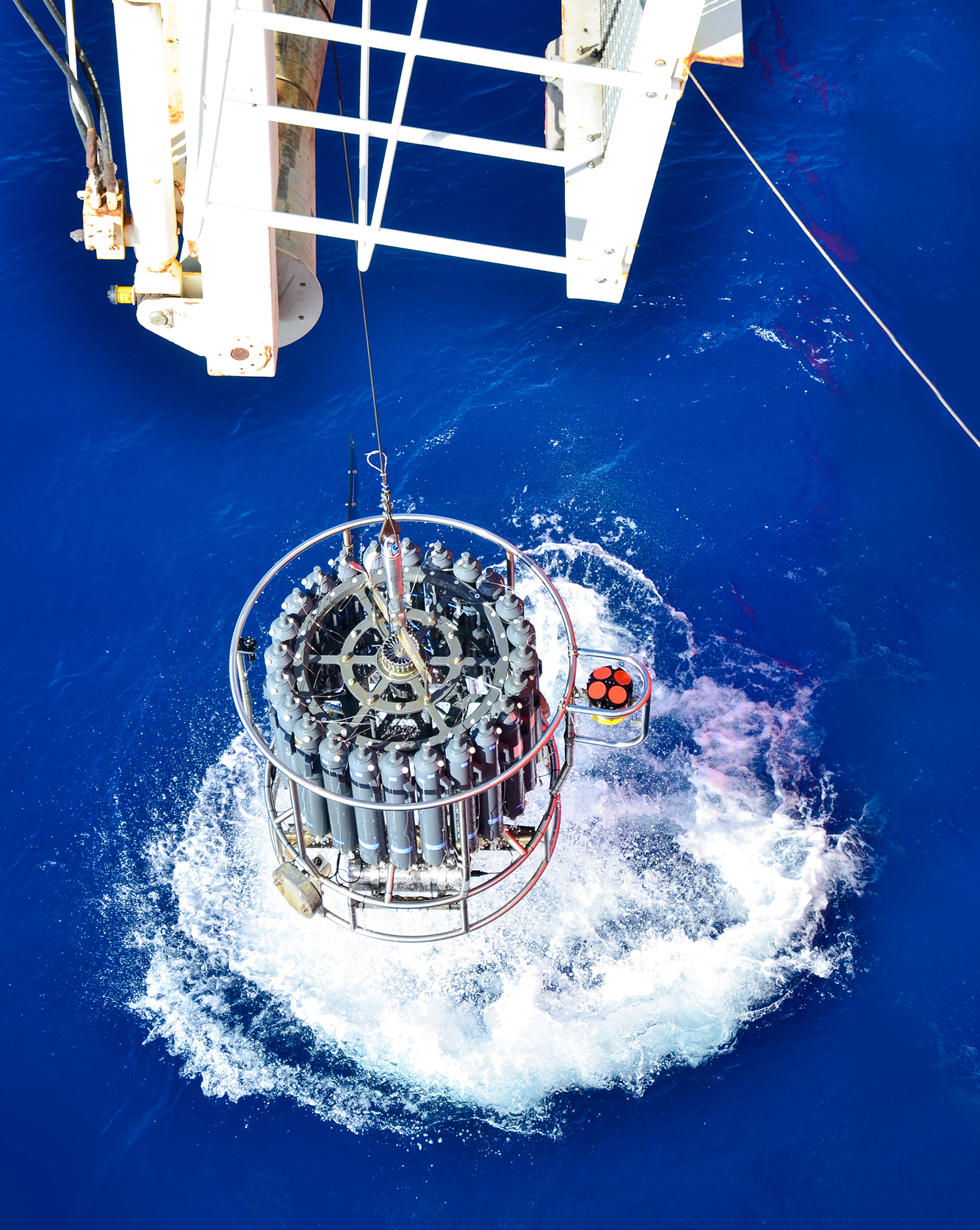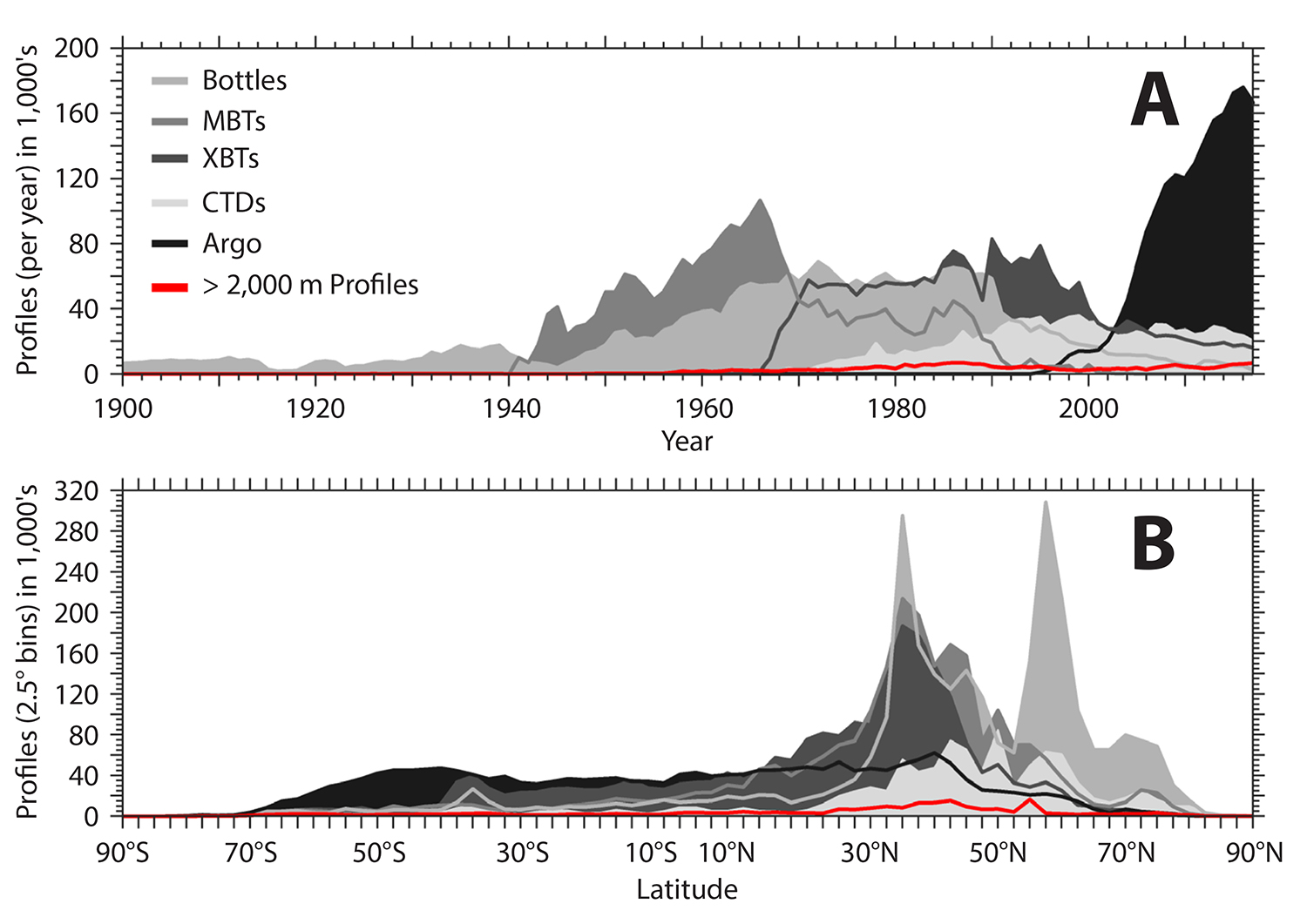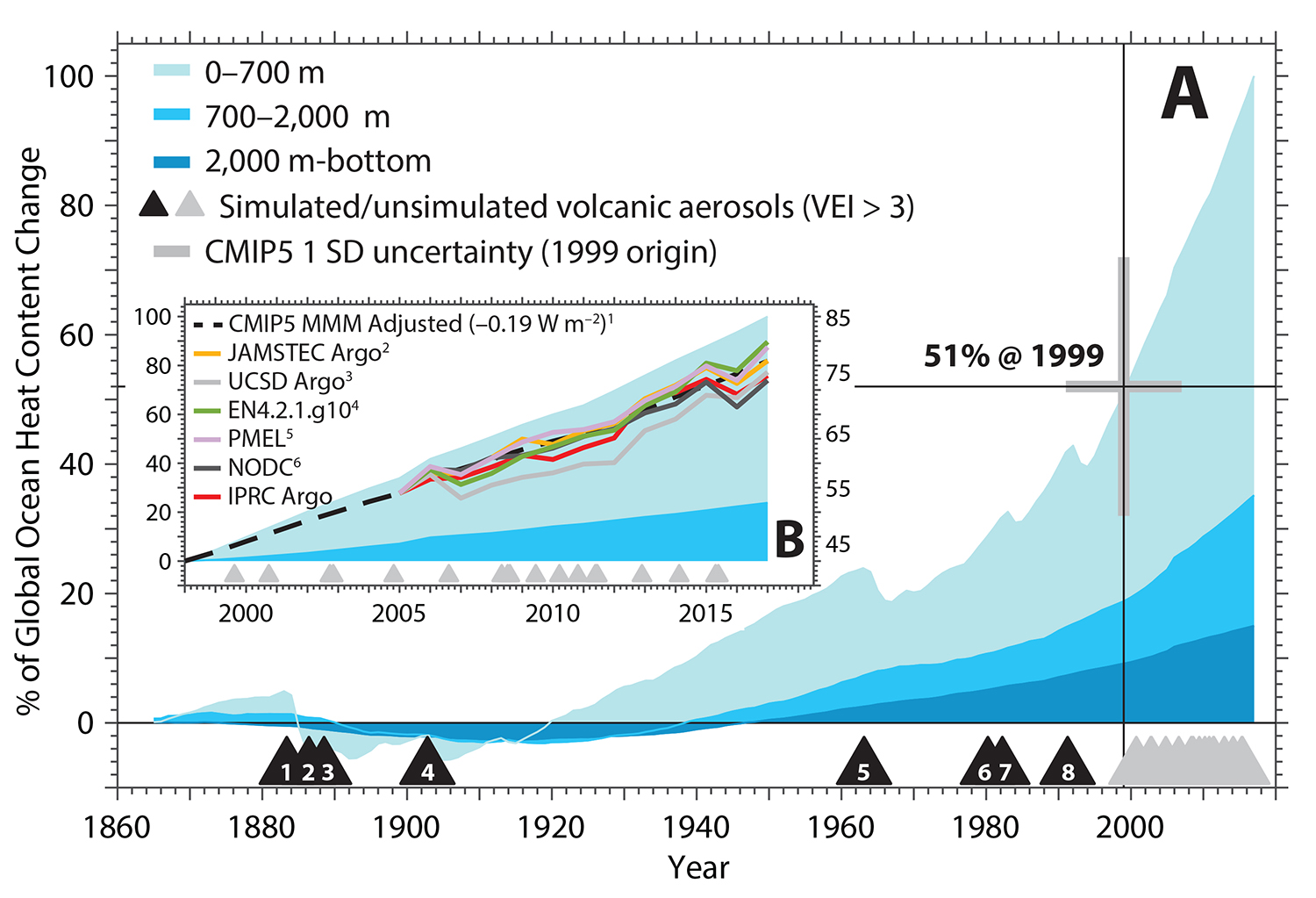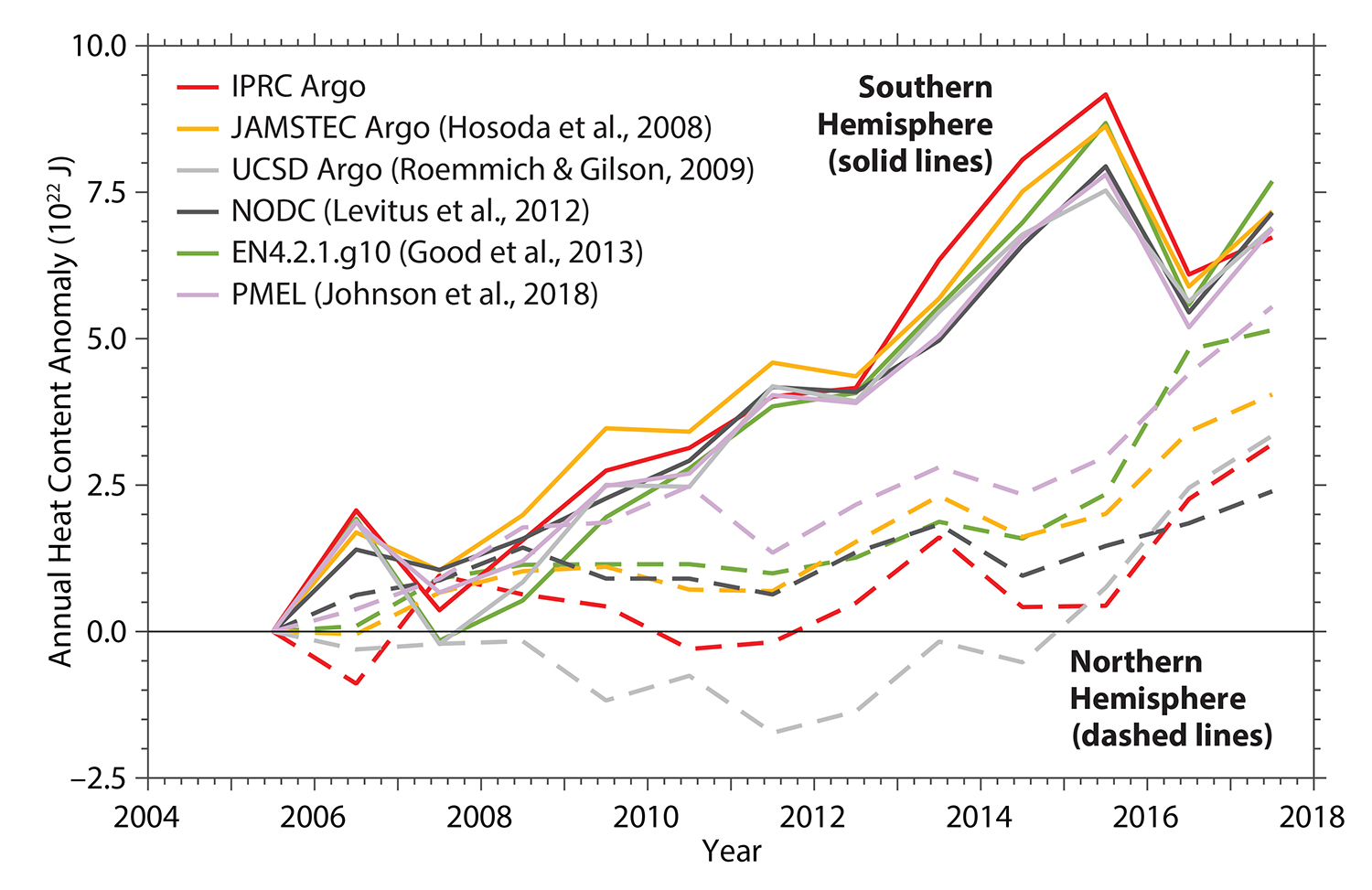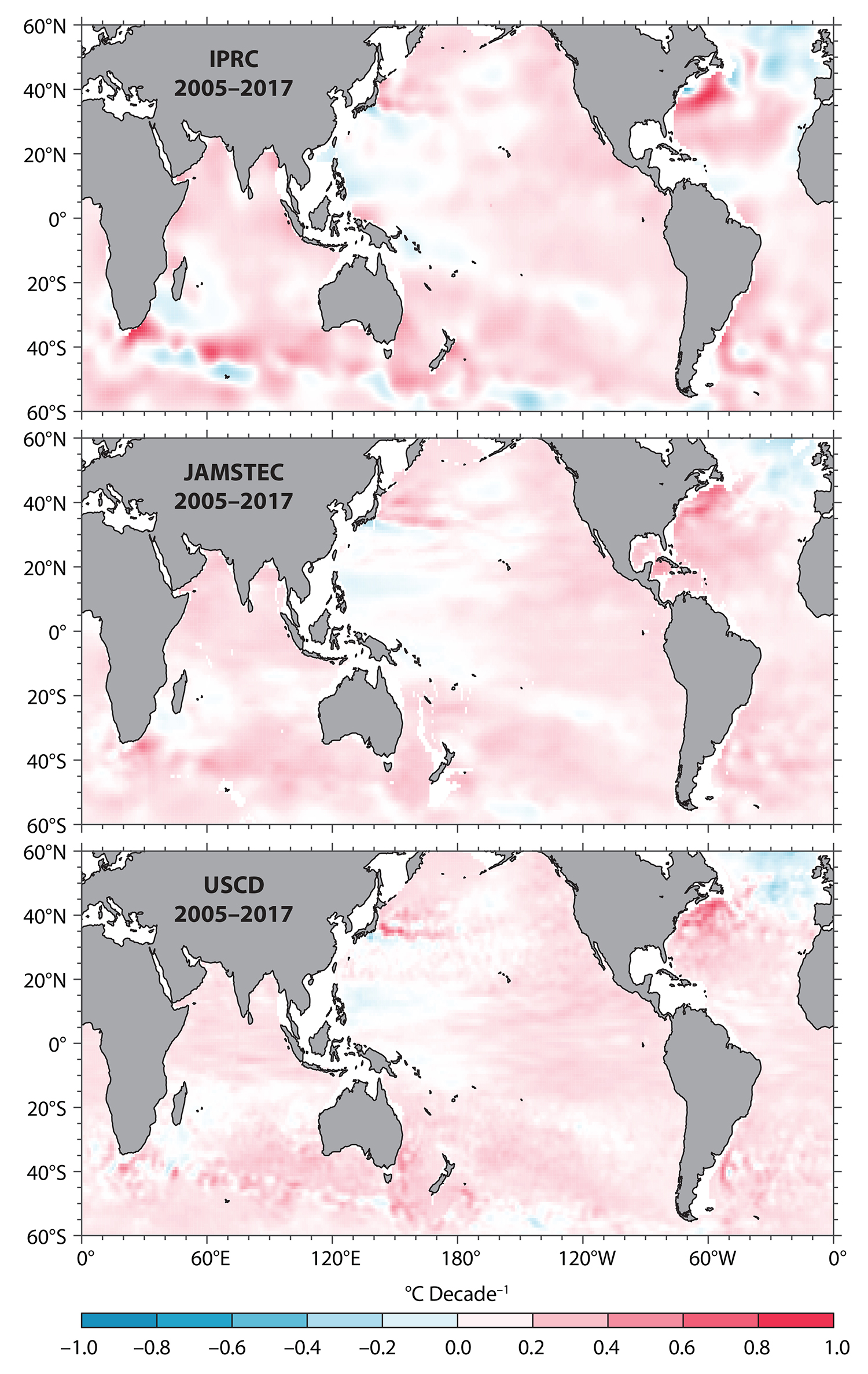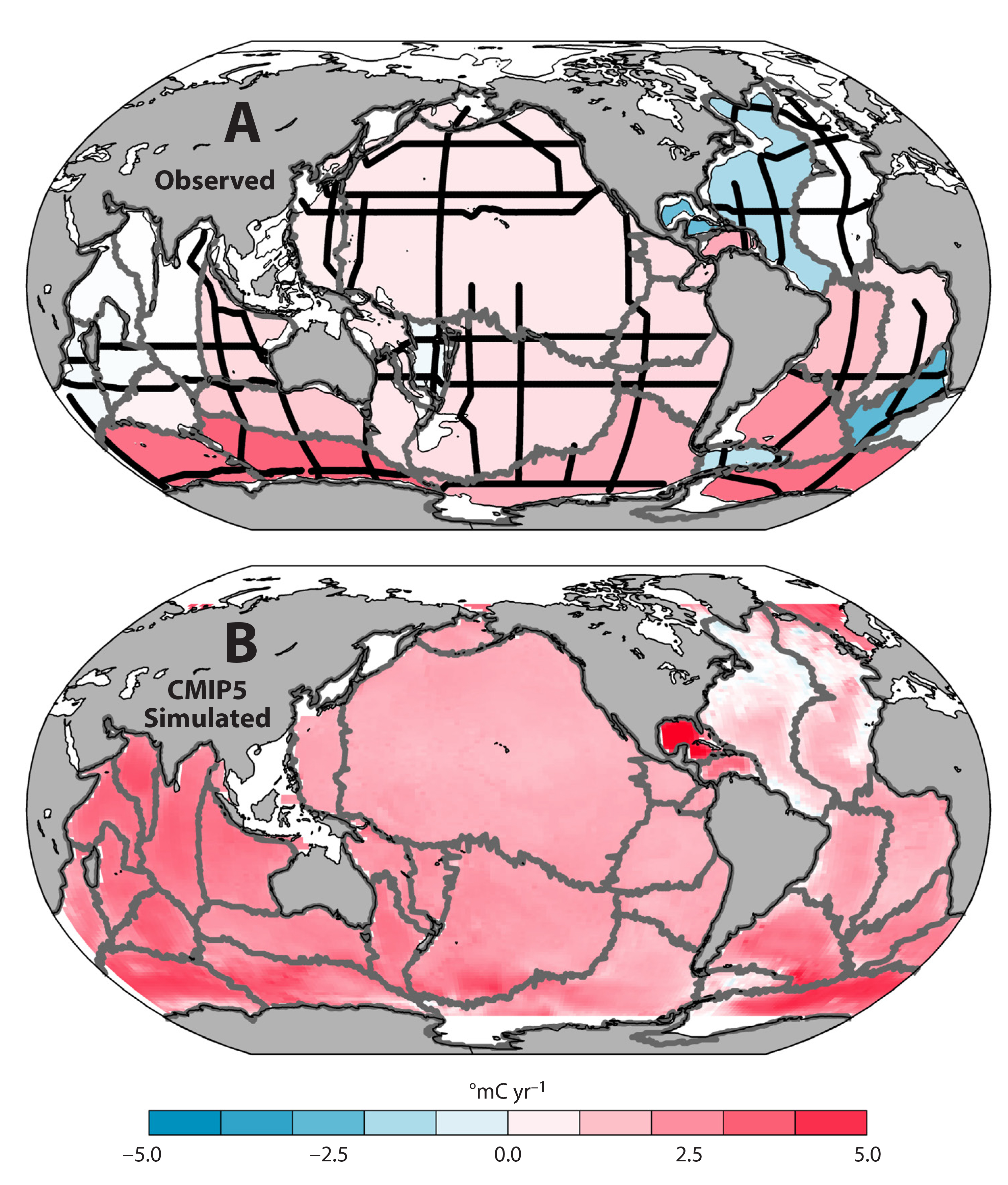Abraham, J.P., M. Baringer, N.L. Bindoff, T. Boyer, L.J. Cheng, J.A. Church, J.L. Conroy, C.M. Domingues, J.T. Fasullo, J. Gilson, and others. 2013. A review of global ocean temperature observations: Implications for ocean heat content estimates and climate change. Reviews of Geophysics 51(3):450–483, https://doi.org/10.1002/rog.20022.
Baker, D.J., R.W. Schmitt, and C. Wunsch. 2007. Endowments and new institutions for long-term observation. Oceanography 20(4):10–14, https://doi.org/10.5670/oceanog.2007.19.
Boyer, T.P., O.K. Baranova, C. Coleman, H.E. Garcia, A. Grodsky, R.A. Locarnini, A.V. Mishonov, T.D. O’Brien, C.R. Paver, J.R. Reagan, and others. 2018. World Ocean Database 2018: Chapter 1. Introduction. NOAA Atlas NESDIS NCEI, Silver Spring, Maryland, USA, https://data.nodc.noaa.gov/woa/WOD/DOC/wod_intro.pdf.
Boyer, T., C.M. Domingues, S.A. Good, G.C. Johnson, J.M. Lyman, M. Ishii, V. Gouretski, J.K. Willis, J. Antonov, S. Wijffels, and others. 2016. Sensitivity of global upper-ocean heat content estimates to mapping methods, XBT bias corrections, and baseline climatologies. Journal of Climate 29(13):4,817–4,842, https://doi.org/10.1175/JCLI-D-15-0801.1.
Caesar, L., S. Rahmstorf, A. Robinson, G. Feulner, and V. Saba. 2018. Observed fingerprint of a weakening Atlantic Ocean overturning circulation. Nature 556(7700):191–196, https://doi.org/10.1038/s41586-018-0006-5.
Cai, M. 2005. Dynamical amplification of polar warming. Geophysical Research Letters 32, L22710, https://doi.org/10.1029/2005GL024481.
Cheng, L., J. Abraham, G. Goni, T. Boyer, S. Wijffels, R. Cowley, V. Gouretski, F. Reseghetti, S. Kizu, S. Dong, and others. 2016a. XBT Science: Assessment of instrumental biases and errors. Bulletin of the American Meteorological Society 97(6):924–933, https://doi.org/10.1175/BAMS-D-15-00031.1.
Cheng, L., K.E. Trenberth, J. Fasullo, T. Boyer, J. Abraham, and J. Zhu. 2017. Improved estimates of ocean heat content from 1960 to 2015. Science Advances 3(3):e1601545, https://doi.org/10.1126/sciadv.1601545.
Cheng, L., K.E. Trenberth, M.D. Palmer, J. Zhu, and J.P. Abraham. 2016b. Observed and simulated full-depth ocean heat-content changes for 1970–2005. Ocean Sciences 12(4):925–935, https://doi.org/10.5194/os-12-925-2016.
Cheng, L., and J. Zhu. 2014. Artifacts in variations of ocean heat content induced by the observation system changes. Geophysical Research Letters 41(20):7,276–7,283, https://doi.org/10.1002/2014GL061881.
Covey, C., P.J. Gleckler, T.J. Phillips, and D.C. Bader. 2006. Secular trends and climate drift in coupled ocean-atmosphere general circulation models. Journal of Geophysical Research 111, D03107, https://doi.org/10.1029/2005JD006009.
Desbruyeres, D.G., S.G. Purkey, E.L. McDonagh, G.C. Johnson, and B.A. King. 2016. Deep and abyssal ocean warming from 35 years of repeat hydrography. Geophysical Research Letters 43(19):10,356–10,365, https://doi.org/10.1002/2016GL070413.
Domingues, C.M., J.A. Church, N.J. White, P.J. Gleckler, S.E. Wijffels, P.M. Barker, and J.R. Dunn. 2008. Improved estimates of upper-ocean warming and multi-decadal sea-level rise. Nature 453(7198):1,090–1,093, https://doi.org/10.1038/nature07080.
Domingues, C.M., and M.D. Palmer. 2015. The IQuOD initiative: Towards an international quality controlled ocean database. CLIVAR Exchanges 67(19, 2):38–40, http://www.clivar.org/documents/exchanges-67.
Durack, P.J., P.J. Gleckler, F.W. Landerer, and K.E. Taylor. 2014. Quantifying underestimates of long-term upper-ocean warming. Nature Climate Change 4(11):999–1,005, https://doi.org/10.1038/nclimate2389.
Durack, P.J., T. Lee, N.T. Vinogradova, and D. Stammer. 2016. Keeping the lights on for global ocean salinity observation. Nature Climate Change 6(3):228–231, https://doi.org/10.1038/nclimate2946.
Durack, P.J., K.E. Taylor, V. Eyring, S.K. Ames, T. Hoang, D. Nadeau, C. Doutriaux, M. Stockhause, and P.J. Gleckler. 2018. Toward standardized data sets for climate model experimentation. EOS 99, https://doi.org/10.1029/2018EO101751.
Durack, P.J., and S.E. Wijffels. 2010. Fifty-year trends in global ocean salinities and their relationship to broadscale warming. Journal of Climate 23:4,342–4,362, https://doi.org/10.1175/2010JCLI3377.1.
Durack, P.J., S.E. Wijffels, and T.P. Boyer. 2013. Long-term salinity changes and implications for the global water cycle. Pp. 727–757 in Ocean Circulation and Climate: A 21st Century Perspective. G. Siedler, S.M. Griffies, J. Gould, and J.A. Church, eds, International Geophysics, vol. 103, Academic Press, Elsevier, Oxford, UK, https://doi.org/10.1016/B978-0-12-391851-2.00028-3.
Eyring, V., S. Bony, G.A. Meehl, C.A. Senior, B. Stevens, R.J. Stouffer, and K.E. Taylor. 2016. Overview of the Coupled Model Intercomparison Project Phase 6 (CMIP6) experimental design and organization. Geoscientific Model Development 9(5):1,937–1,958, https://doi.org/10.5194/gmd-9-1937-2016.
Flato, G., J. Marotzke, B. Abiodun, P. Braconnot, S.C. Chou, W. Collins, P. Cox, F. Driouech, S. Emori, V. Eyring, and others. 2013. Evaluation of climate models. Pp. 741–866 in Climate Change 2013: The Physical Science Basis. Contribution of Working Group I to the Fifth Assessment Report of the Intergovernmental Panel on Climate Change. T.F. Stocker, D. Qin, G.-K. Plattner, M. Tignor, S.K. Allen, J. Boschung, A. Nauels, Y. Xia, V. Bex, and P. M. Midgley, eds, Cambridge University Press, Cambridge, United Kingdom, and New York, NY, USA, https://doi.org/10.1017/CBO9781107415324.020.
Frölicher, T.L., E.M Fischer, and N. Gruber. 2018. Marine heatwaves under global warming. Nature 560(7718):350–364, https://doi.org/10.1038/s41586-018-0383-9.
Gillett, N.P., D.A. Stone, P.A. Stott, T. Nozawa, A.Y. Karpechko, G.C. Hegerl, M.F. Wehner, and P.D. Jones. 2008. Attribution of polar warming to human influence. Nature Geoscience 1(11):750–754, https://doi.org/10.1038/ngeo338.
Gleckler, P.J., P.J. Durack, R.J. Stouffer, G.C. Johnson, and C.E. Forest. 2016. Industrial-era global ocean heat uptake doubles in recent decades. Nature Climate Change 6(4):394–398, https://doi.org/10.1038/nclimate2915.
Good, S.A., M.J. Martin, and N.A. Rayner. 2013. EN4: Quality controlled ocean temperature and salinity profiles and monthly objective analyses with uncertainty estimates. Journal of Geophysical Research, 118(12):6,704–6,716. https://doi.org/10.1002/2013JC009067.
Gould, J., D. Roemmich, S. Wijffels, H. Freeland, M. Ignaszewsky, X. Jianping, S. Pouliquen, Y. Desaubies, U. Send, K. Radhakrishnan, and others. 2004. Argo profiling floats bring new era of in situ ocean observations. EOS 85(19):185–191, http://doi.org/10.1029/2004EO190002.
Gouretski, V., and K.P. Koltermann. 2007. How much is the ocean really warming? Geophysical Research Letters 34, L01610, https://doi.org/10.1029/2006GL027834.
Gregory, J.M. 2010. Long-term effect of volcanic forcing on ocean heat content. Geophysical Research Letters 37, L22701, https://doi.org/10.1029/2010GL045507.
Gregory, J.M., D. Bi, M.A. Collier, M.R. Dix, A.C. Hirst, A. Hu, M. Huber, R. Knutti, S.J. Marsland, M. Meinshausen, and others. 2013. Climate models without preindustrial volcanic forcing underestimate historical ocean thermal expansion. Geophysical Research Letters 40(8):1,600–1,604, https://doi.org/10.1002/grl.50339.
Griffies, S.M., M. Winton, W.G. Anderson, R. Benson, T.L. Delworth, C.O. Dufour, J.P. Dunne, P. Goddard, A.K. Morrison, A. Rosati, and others. 2015. Impacts on ocean heat from transient mesoscale eddies in a hierarchy of climate models. Journal of Climate 28(3):952–977, https://doi.org/10.1175/JCLI-D-14-00353.1.
Heuze, C., K.J. Heywood, D.P. Stevens, and J.K. Ridley. 2015. Changes in global ocean bottom properties and volume transports in CMIP5 models under climate change scenarios. Journal of Climate 28(8):2,917–2,944, https://doi.org/10.1175/JCLI-D-14-00381.1.
Hobbs, W., M.D. Palmer, and D. Monselesan. 2016. An energy conservation analysis of ocean drift in the CMIP5 global coupled models. Journal of Climate 29(5):1,639–1,653, https://doi.org/10.1175/JCLI-D-15-0477.1.
Hobday, A.J., E.C.J. Oliver, A. Sen Gupta, J.A. Benthuysen, M.T. Burrows, M.G. Donat, N.J. Holbrook, P.J. Moore, M.S. Thomsen, T. Wernberg, and D.A. Smale. 2018. Categorizing and naming marine heatwaves. Oceanography 31(2):162–173, https://doi.org/10.5670/oceanog.2018.205.
Holland, M.M., and C.M. Bitz. 2003. Polar amplification of climate change in coupled models. Climate Dynamics 21(3–4):221–232, https://doi.org/10.1007/s00382-003-0332-6.
Hosoda, S., T. Ohira, and T. Nakamura. 2008. A monthly mean dataset of global oceanic temperature and salinity derived from Argo float observations. JAMSTEC Report of Research and Development 8:47–59, https://doi.org/10.5918/jamstecr.8.47.
IPRC (International Pacific Research Center). 2015. Products based on Argo Data. Available online at http://apdrc.soest.hawaii.edu/projects/argo/.
Ishii, M., M. Kimoto, and M. Kachi. 2003. Historical ocean subsurface temperature analysis with error estimates. Monthly Weather Review 131(1):51–73, https://doi.org/10.1175/1520-0493(2003)131<0051:HOSTAW>2.0.CO;2.
Jayne, S.R., D. Roemmich, N. Zilberman, S.C. Riser, K.S. Johnson, G.C. Johnson, and S.R. Piotrowicz. 2017. The Argo program: Present and future. Oceanography 30(2):18–28, https://doi.org/10.5670/oceanog.2017.213.
Johnson, G.C., J.M. Lyman, T. Boyer, L. Cheng, C.M. Domingues, J. Gilson, M. Ishii, R. Killick, D. Monselesan, S.G. Purkey, and S.E. Wijffels. 2018. Global oceans: Ocean heat content. State of the Climate in 2017. Bulletin of the American Meteorological Society 99(8):S72–S77, https://doi.org/10.1175/2018BAMSStateoftheClimate.1.
Johnson, G.C., J.M. Lyman, and S.G. Purkey. 2015. Informing Deep Argo array design using Argo and full-depth hydrographic section data. Journal of Atmospheric and Oceanic Technology 32(11):2,187–2,198, https://doi.org/10.1175/JTECH-D-15-0139.1.
Johnson, K.S., W.M. Berelson, E.S. Boss, Z. Chase, H. Claustre, S.R. Emerson, N. Gruber, A. Kortzinger, M.J. Perry, and S.C. Riser. 2009. Observing biogeochemical cycles at global scales with profiling floats and gliders: Prospects for a global array. Oceanography 22(3):216–225, https://doi.org/10.5670/oceanog.2009.81.
Josey, S.A., J.J.-M. Hirschi, B. Sinha, A. Duchez, J.P. Grist, and R. Marsh. 2018. The recent Atlantic cold anomaly: Causes, consequences, and related phenomena. Annual Review of Marine Science 10:475–501, https://doi.org/10.1146/annurev-marine-121916-063102.
Kortzinger, A., J. Schimanski, and U. Send. 2005. High quality oxygen measurements from profiling floats: A promising new technique. Journal of Atmospheric and Oceanic Technology 22(3):302–308, https://doi.org/10.1175/JTECH1701.1.
Landerer, F.W., P.J. Gleckler, and T. Lee. 2014. Evaluation of CMIP5 dynamic sea surface height multi-model simulations against satellite observations. Climate Dynamics 43(5–6):1,271–1,283, https://doi.org/10.1007/s00382-013-1939-x.
Le Reste, S., V. Dutreuil, X. Andre, V. Thierry, C. Renaut, P.-Y. Le Traon, and G. Maze. 2016. “Deep-Arvor”: A new profiling float to extend the Argo observations down to 4000-m depth. Journal of Atmospheric and Oceanic Technology 33(5):1,039–1,055, https://doi.org/10.1175/JTECH-D-15-0214.1.
Levitus, S., J.I. Antonov, T P. Boyer, O.K. Baranova, H.E. Garcia, R.A. Locarnini, A.V. Mishonov, J.R. Reagan, D. Seidov, E.S. Yarosh, and M.M. Zweng. 2012. World ocean heat content and thermosteric sea level change (0–2000 m), 1955–2010. Geophysical Research Letters 39, L10603, https://doi.org/10.1029/2012GL051106.
Levitus, S., J.I. Antonov, T.P. Boyer, and C. Stephens. 2000. Warming of the world ocean. Science 287(5461):2,225–2,229, https://doi.org/10.1126/science.287.5461.2225.
Liu, W., and S.-P. Xie. 2018. An ocean view of the global surface warming hiatus. Oceanography 31(2):72–79, https://doi.org/10.5670/oceanog.2018.217.
Lyman, J.M., S.A. Good, V.V. Gouretski, M. Ishii, G.C. Johnson, M.D. Palmer, D.A. Smith, and J.K. Willis. 2010. Robust warming of the global upper ocean. Nature 465(7296):334–337, https://doi.org/10.1038/nature09043.
Lyman, J.M., and G.C. Johnson. 2014. Estimating global ocean heat content changes in the upper 1800 m since 1950 and the influence of climatology choice. Journal of Climate 27(5):1,945–1,957, https://doi.org/10.1175/JCLI-D-12-00752.1.
Medhaug, I., M.B. Stolpe, E.M. Fischer, and R. Knutti. 2017. Reconciling controversies about the ‘global warming hiatus.’ Nature 545(7652):41–47, https://doi.org/10.1038/nature22315.
Meehl, G.A., C. Covey, T. Delworth, M. Latif, B. McAvaney, J.F.B. Mitchell, R.J. Stouffer, and K.E. Taylor. 2007. The WCRP CMIP3 multimodel dataset: A new era in climate change research. Bulletin of the American Meteorological Society 88(9):1,383–1,394, https://doi.org/10.1175/BAMS-88-9-1383.
National Academies of Sciences, Engineering, and Medicine. 2017. Sustaining Ocean Observations to Understand Future Changes in Earth’s Climate. The National Academies Press, Washington, DC, https://doi.org/10.17226/24919.
Newsom, E.R., C.M. Bitz, F.O. Bryan, R. Abernathy, and P.R. Gent. 2016. Southern Ocean deep circulation and heat uptake in a high-resolution climate model. Journal of Climate 29(7):2,597–2,619, https://doi.org/10.1175/JCLI-D-15-0513.1.
Palmer, M.D. 2017. Reconciling estimates of ocean heating and Earth’s radiation budget. Current Climate Change Reports 3(1):78–86, https://doi.org/10.1007/s40641-016-0053-7.
Palmer, M.D., T. Boyer, R. Cowley, S. Kizu, F. Reseghetti, T. Suzuki, and A. Thresher. 2018. An algorithm for classifying unknown expendable bathythermograph (XBT) instruments based on existing metadata. Journal of Atmospheric and Oceanic Technology 35(3):429–440, https://doi.org/10.1175/JTECH-D-17-0129.1.
Palmer, M.D., S.A. Good, K. Haines, N.A. Rayner, and P.A. Stott. 2009. A new perspective on warming of the global oceans. Geophysical Research Letters 36, L20709, https://doi.org/10.1029/2009GL039491.
Palmer, M.D., and D.J. McNeall. 2014. Internal variability of Earth’s energy budget simulated by CMIP5 climate models. Environmental Research Letters 9(3):034016, https://doi.org/10.1088/1748-9326/9/3/034016.
Palmer, M.D., D.J. McNeall, and N.J. Dunstone. 2011. Importance of the deep ocean for estimating decadal changes in Earth’s radiation balance. Geophysical Research Letters 38, L13707, https://doi.org/10.1029/2011GL047835.
Palmer, M.D., C.D. Roberts, M. Balmaseda, Y.-S. Chang, G. Chepurin, N. Ferry, Y. Fujii, S.A. Good, S. Guinehut, K. Haines, and others. 2017. Ocean heat content variability and change in an ensemble of ocean reanalyses. Climate Dynamics 49(3):909–930, https://doi.org/10.1007/s00382-015-2801-0.
Penduff, T., G. Sérazin, S. Leroux, S. Close, J.-M. Molines, B. Barnier, L. Bessières, L. Terray, and G. Maze. 2018. Chaotic variability of ocean heat content: Climate-relevant features and observational implications. Oceanography 31(2):63–71, https://doi.org/10.5670/oceanog.2018.210.
Pershing, A.J., K.E. Mills, A.M. Dayton, B.S. Franklin, and B.T. Kennedy. 2018. Evidence for adaptation from the 2016 marine heatwave in the Northwest Atlantic Ocean. Oceanography 31(2):152–161, https://doi.org/10.5670/oceanog.2018.213.
Polyakov, I.V., G.V. Alekseev, R.V. Bekryaev, U. Bhatt, R.L. Colony, M.A. Johnson, V.P. Karklin, A.P. Makshtas, D. Walsh, and A.V. Yulin. 2002. Observationally based assessment of polar amplification of global warming. Geophysical Research Letters 29(18):25-1–25-4, https://doi.org/10.1029/2001GL011111.
Purkey S.G., and G.C. Johnson. 2010. Warming of global abyssal and deep Southern Ocean waters between 1990s and 2000s: Contributions to global heat and sea level rise budgets. Journal of Climate 23(23):6,336–6,351, https://doi.org/10.1175/2010JCLI3682.1.
Rahmstorf, S. 1995. Climate drift in an ocean model coupled to a simple, perfectly matched atmosphere. Climate Dynamics 11(8):447–458, https://doi.org/10.1007/BF00207194.
Rhein, M., S.R. Rintoul, S. Aoki, E. Campos, D. Chambers, R.A. Feely, S. Gulev, G.C. Johnson, S.A. Josey, A. Kostianoy, and others. 2013. Observations: Ocean. Pp. 255–315 in Climate Change 2013: The Physical Science Basis. Contribution of Working Group I to the Fifth Assessment Report of the Intergovernmental Panel on Climate Change. T.F. Stocker, D. Qin, G.-K. Plattner, M. Tignor, S.K. Allen, J. Boschung, A. Nauels, Y. Xia, V. Bex, and P. M. Midgley, eds, Cambridge University Press, Cambridge, United Kingdom and New York, NY, USA, https://doi.org/10.1017/CBO9781107415324.010.
Ridley, D.A., S. Solomon, J.E. Barnes, V.D. Burlakov, T. Deshler, S.I. Dolgii, A.B. Herber, T. Nagai, R.R. Neely III, A.V. Nevzorov, and others. 2014. Total volcanic stratospheric aerosol optical depths and implications for global climate change. Geophysical Research Letters 41(22):7,763–7,769, https://doi.org/10.1002/2014GL061541.
Riser, S.C., H.J. Freeland, D. Roemmich, S. Wijffels, A. Troisi, M. Belbeoch, D. Gilbert, J. Xu, S. Pouliquen, A. Thresher, and others. 2016. Fifteen years of ocean observations with the global Argo array. Nature Climate Change 6(2):145–153, https://doi.org/10.1038/nclimate2872.
Robson, J., P. Ortega, and R. Sutton. 2016. A reversal of climatic trends in the North Atlantic since 2005. Nature Geoscience 9(7):513–517, https://doi.org/10.1038/ngeo2727.
Roemmich, D., J. Church, J. Gilson, D. Monselesan, P. Sutton, and S. Wijffels. 2015. Unabated planetary warming and its ocean structure since 2006. Nature Climate Change 5(3):240–245, https://doi.org/10.1038/nclimate2513.
Roemmich, D., and J. Gilson. 2009. The 2004–2008 mean and annual cycle of temperature, salinity, and steric height in the global ocean from the Argo Program. Progress in Oceanography 82(2):81–100, https://doi.org/10.1016/j.pocean.2009.03.004.
Rugenstein, M.A., A.J. Sedlacek, and R. Knutti. 2016. Nonlinearities in patterns of long-term ocean warming. Geophysical Research Letters 43(7):3,380–3,388, https://doi.org/10.1002/2016GL068041.
Saba, V.S., S.M. Griffies, W.G. Anderson, M. Winton, M.A. Alexander, T.L. Delworth, J.A. Hare, M.J. Harrison, A. Rosati, G.A. Vecchi, and R. Zhang. 2016. Enhanced warming of the Northwest Atlantic Ocean under climate change. Journal of Geophysical Research 121(1):118–132, https://doi.org/10.1002/2015JC011346.
Sallée, J.-B. 2018. Southern Ocean warming. Oceanography 31(2):52–62, https://doi.org/10.5670/oceanog.2018.215.
Santer, B.D., C. Bonfils, J.F. Painter, M.D. Zelinka, C. Mears, S. Solomon, G.A. Schmidt, J.C. Fyfe, J.N.S. Cole, L. Nazarenko, and others. 2014. Volcanic contribution to decadal changes in tropospheric temperature. Nature Geoscience 7(3):185–189, https://doi.org/10.1038/ngeo2098.
Santer, B.D., J.C. Fyfe, G. Pallotta. G.M. Flato, G.A. Meehl, M.H. England, E. Hawkins, M.E. Mann, J.F. Painter, C. Bonfils, and others. 2017. Causes of differences in model and satellite tropospheric warming rates. Nature Geoscience 10(7):478–485, https://doi.org/10.1038/ngeo2973.
Schmidt, A., M.J. Mills, S. Ghan, J.M. Gregory, R.P. Allan, T. Andrews, C.G. Bardeen, A. Conley, P.M. Forster, A. Gettelman, and others. 2018. Volcanic radiative forcing from 1979 to 2015. Geophysical Research Letters, https://doi.org/10.1029/2018JD028776.
Schmidt, G.A., D.T. Shindell, and K. Tsigaridis. 2014. Reconciling warming trends. Nature Geoscience 7(3):158–160, https://doi.org/10.1038/ngeo2105.
Schmitt, R.W. 2018. The ocean’s role in climate. Oceanography 31(2):32–40, https://doi.org/10.5670/oceanog.2018.225.
Sen Gupta, A., N.C. Jourdain, J.N. Brown, and D. Monselesan. 2013. Climate drift in the CMIP5 models. Journal of Climate 26(21):8,597–8,615, https://doi.org/10.1175/JCLI-D-12-00521.1.
Sen Gupta, A., L.C. Muir, J.N. Brown, S.J. Phipps, P.J. Durack, D. Monselesan, and S.E. Wijffels. 2012. Climate drift in the CMIP3 models. Journal of Climate 25(13):4,621–4,640, https://doi.org/10.1175/JCLI-D-11-00312.1.
Stammer, D., A. Bracco, P. Braconnot, G.P. Brasseur, S.M. Griffies, and E. Hawkins. In press. Science directions in a post COP21 world of transient climate change: Enabling regional to local predictions in support of reliable climate information. Earth’s Future, https://doi.org/10.1029/2018EF000979.
Taylor, K.E., R.J. Stouffer, and G.A. Meehl. 2012. An overview of CMIP5 and the experiment design. Bulletin of the American Meteorological Society 93(4):485–498, https://doi.org/10.1175/BAMS-D-11-00094.1.
von Schuckmann, K., M.D. Palmer, K.E. Trenberth, A. Cazenave, D. Chambers, N. Champollion, J. Hansen, S.A. Josey, N. Loeb, P.-P. Mathieu, and others. 2016. An imperative to monitor Earth’s energy imbalance. Nature Climate Change 6(2):138–144, https://doi.org/10.1038/nclimate2876.
WCRP Global Sea Level Budget Group. 2018. Global sea-level budget 1993–present. Earth System Science Data 10:1,551–1,590, https://doi.org/10.5194/essd-10-1551-2018.
Wunsch, C. 2016. Global ocean integrals and means, with trend implications. Annual Review of Marine Science 8:1–33, https://doi.org/10.1146/annurev-marine-122414-034040.
Wunsch, C., R.W. Schmitt, and D.J. Baker. 2013. Climate change as an intergenerational problem. Proceedings of the National Academy of Sciences of the United States of America 110(12):4,435–4,436, https://doi.org/10.1073/pnas.1302536110.


